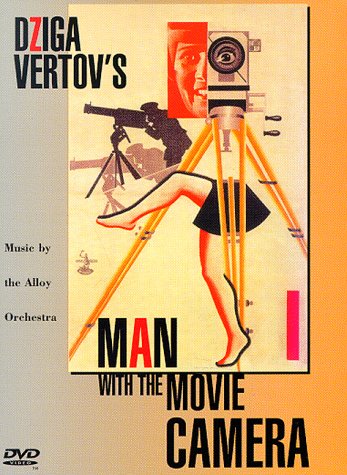Montopolis Scores 'Man with a Movie Camera'
 By John Elder
By John Elder
I'll go ahead and say it: 3D movies are AWESOME. But what's next? What comes after 3D? Perhaps 4D? Maybe 3D plus smell?
After viewing Man with a Movie Camera this past week, I believe I have the answer. Visualize a film where not only the picture jumps out at you, but the music jumps out at you too. 3D music. I'm talking about taking a real band, putting them right there in the theater, and having them perform the soundtrack live as you sit back and enjoy the film. I'm thinking the future of film is at least 7D. That's right. 3D visuals plus 3D audio and add in 1D for great food and drink at The Alamo Drafthouse and we're talking about a full on 7D experience.
Now let's take a step back. Man with a Movie Camera was an awesome experience, but it was released 83 years ago in 1929, so it was not "real" 3D. This didn't matter, because, like I said, I was able to take in this classic flick while a live band performed an original score. Bravo to these musicians! All seemed to be Austin locals and very active in the music scene. The band was led by Justin Sherburn and consisted of a six-piece group called Montopolis.
This was a film about film, and that truly is multi-dimensional. I know, its probably not the first time you've seen or heard of a "film about film," and it certainly will not be the last time. That in itself says a lot about the influence of Man with a Movie Camera, because it is the grandaddy of all films about film. We nearly start and end in a movie theater. What could be more fitting? There is a brilliant sequence where blinking eyes and opening and closing shades are juxtaposed with the viewing of a rack focus and iris adjustment. It is clear the director means to show the camera as the human eye or vice versa.
Film also involves editing and we see this process too. At one point the film or moving image stops and still frames are shown. These still frames are then shown with shots of an editor, the director's wife, cutting and putting pieces of film together. This cleverly shows how film worked; the still frames helped to illustrate that the film being cut by the editor was actually just made up of many frames in sequence. Another section shows a haircut, knitting, and an editor cutting film all together. Later, a scene is cut together with shots of magic tricks and other forms of entertainment. Is this magic, or movie magic? It seems the filmmakers have gone great lengths to show we mirror our films, and our films mirror us.
You may have guessed Man with a Movie Camera is not your typical Hollywood fare. It's actually a product of the Soviet Union, and in fact, portrays a day in the life of the Soviet City, Odessa, as well as other cities. This film, directed by Dziga Vertov, is experimental and very complex. I've barely even begun to scratch the surface, if at all. It has clearly inspired many films, and brings to mind other complex, beautiful pictures like Koyannisqatsi. Even if you're not into this sort of thing, if you have the opportunity to view it with a live band, you should do it.
Justin Sherburn and Montopolis undoubtedly added another dimension to Man with a Movie Camera, or maybe even three; experiencing it was great and new. And by the way, did I mention the live music thing is actually old? It was standard in theaters before we learned to record audio and film. So in a way, this was a look into the past, and it was terrific!
John Elder is an intern at the Austin Film Society.

